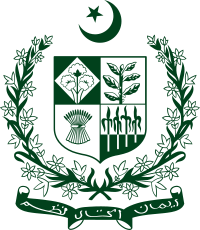Cabinet Committee on National Security (Pakistan)
 |
|---|
|
|
The Cabinet Committee on National Security (CCNS or C2NS), (
Since its creation and inception under Prime minister
History
Inception and creation:1976–1991
In 1969, the concept of National Security Council was established by President
As an aftermath of
Ultimately, Prime minister Bhutto published the
DCC reorganisations and expansion: 1991–1999
In 1994, the DCC was again operationalised and had conducted fewer meetings between the Prime minister and prime minister's chief military advisers.
Since India's second nuclear tests, Pokhran-II in 1998, the nuclear weapons politics, nuclear restraints, and nuclear weapons exercise, has been integrated in the operational mandate of DCC council.[8] The DCC council provided a meaningful and mutual environment of understanding of national security issues between the Pakistan Armed Forces and the civilian institutions.[8] In May 1998, the repeated and emergency meetings of DCC provided a great environment of its performance when Prime minister Nawaz Sharif ordered Pakistan's first public nuclear tests, Chagai-I which was followed by Chagai-II, after the DCC council conveyed various civil-military sessions with the Prime minister and the military leadership.[8]
Decision-making in matters of defence is to be a coordinated effort by the DCC council between the civil and the military elements in Pakistan.
Developments and meetings:2008 – present
The CCNS is not restricted to the key cabinet ministers, and any cabinet ministers can also attend the meeting.
Since 2008, the role of Defence Cabinet Committee, Parliament and its committees has increased.[4] The military science circles is more forthcoming in giving briefings on national security issues to the Parliament and high-ranking civilians than it was in General Musharraf's period.[4]
Parliament access and committees
- Standing Committee on Defence and Defence Production[4]
- Parliamentary Standing Committee on National Security[4]
- Standing Committee on Defence[4]
- Public Accounts Committee[4]
Structure

| Official Designation | Government Secretariat and Offices |
|---|---|
| Chairman | Prime Minister of Pakistan |
| Principal Military Adviser | Joint Chiefs of Staff Committee
|
| Intelligence Adviser(s) | |
| National Intelligence Coordination Committee | |
| Science Advisor | Science Adviser to the Government |
| Cabinet Ministers | National Security Adviser |
| Interior Minister | |
| Finance Minister | |
| Foreign Affairs Adviser | |
| Military leadership | Chief of Army Staff of Pakistan Army
|
Chief of Naval Staff of Pakistan Navy
| |
Chief of Air Staff of Pakistan Air Force
|
References
- ^ "DCC reconstituted as CCNS". The News. 22 August 2013. Retrieved 11 June 2014.
- ^ Press Release. "The Defence Committee of the Cabinet (DCC) met today under the chairmanship of Prime Minister Raja Pervez Ashraf". Pakistan Embassy in Washington D.C. Archived from the original on 27 January 2013. Retrieved 2 March 2013.
- ^ a b c d e f g h i j k l m n Public relations monitoring report. "Performance of the Defence Committee". Pakistan Institute of Legislative Development and Transparency. Retrieved 2 March 2013.
- ^ a b c d e f g h i j k l m n o p Public Monitoring Cell. "National Security Council-debate on Institutions and processes for decision-making on Security issues". Civil-military relations in Pakistan. Retrieved 2 March 2013.
- ^ "Afghanistan & Pakistan Relations.The Timeline". Paklinks.com. 2 October 2004. Archived from the original on 9 September 2012. Retrieved 9 December 2012.
- ISBN 9780312060671. Retrieved 9 December 2012.
- ^ a b Pashtunistan, GlobalSecurity
- ^ a b c Azam, Rai Muhammad Saleh. "The Road to Chagai". When Mountains Move – The Story of Chagai. Defence Journal (The Nations). Archived from the original on 1 April 2012. Retrieved 2 March 2013.


